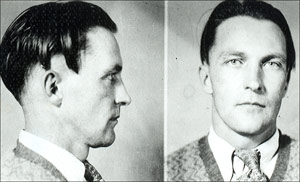Harry Campbell, an ally of gangster Alvin Karpis, had been living a quiet life in Toledo in early 1936.
He had settled with his wife into an apartment in the 2100 block of Monroe Street, probably living off the proceeds of a train robbery in Garrettsville, Ohio the previous November, which netted Karpis, Campbell and other members of the gang $34,000 in cash and $12,450 in securities.
Campbell was wanted for the kidnapping of Edward George Bremer Jr. in St. Paul in 1934, which was worth $200,000 in ransom money. The FBI had spent much time in the mid-1930s rounding up that peculiar variety of 1930s outlaws, who drove fast cars, traveled with women, and committed sensational crimes.

On May 7, 1936, a plane with FBI director J. Edgar Hoover and other G-men landed in Toledo at 2 a.m. By 5 a.m., armed with sawed-off shotguns, Hoover and his agents had surrounded the apartment building. They took Campbell into custody with little incident.
The FBI’s visit to Toledo came six days after the May 1, 1936 arrest of Karpis in New Orleans. It was likely Karpis revealed Campbell’s hideout.
Neighbors “had not an inkling that there was anything wrong with the couple in Apartment No. 1,” the News-Bee said.
A friend of Campbell’s wife told her story to the News-Bee. She knew them as Bob and Gertrude Miller, called Campbell as a perfect gentleman, and described the couple as “seemingly such a loving pair that nobody ever had a suspicion that ‘Bob Miller,’ as I knew him, was a notorious gangster.”
Campbell/Miller had been keeping interesting company. In the aftermath, as the News-Bee’s next-day coverage detailed, it became known that Lucas County Sheriff James O’Reilly had been one of “Miller’s” friends for at least five months, and drank with him, but had no idea who he was.
“I can take it,” O’Reilly said of the accusations, while basically confirming them at the same time.

Toledo Police apparently had no inkling of Campbell’s presence in the city either. They did not participate in the raid.
Toledo Police Chief Ray Allen launched an investigation into the matter. A protest about being ignored by the FBI was met with a sharp reply from Hoover: “My statement of the refusal of G-men to co-operate with corrupt police forces was broader than your chief stated in his protest.”
“I am not prepared to say whether the police should or should not have known of Campbell’s presence in Toledo,” City Manager John Edy said. “That Campbell was captured here without the police knowing of his presence is not necessarily a reflection on the Police Department.”
The next day, an interview with Campbell’s wife appeared in the News-Bee.
“I knew nothing about my husband’s past,” she said. “He never mentioned his past. I never knew the names of any of his former associates. I never heard him mention Karpis.”
Asked if she knew Sheriff James O’Reilly, she said:
“I know of him. I have met him.” She paused. “My name is not connected with him,” she continued, then flitted to a new avowal of loyalty to Campbell.
Both the News-Bee and “their opposition” (The Blade, we’re guessing) called for O’Reilly to resign. “The sheriff’s remarkable failure even to suspect Harry Campbell over the period of some months that the two knew each other does seem to set some kind of new record for official stupidity,” an editorial said.
Did O’Reilly resign? No. The first Lucas County Sheriff elected to a four-year term, he served out his term but was defeated for reelection in 1940, and ran again (and lost) in 1944. He died in 1955. So yes – he could take it.
A few days later, the News-Bee also revealed that rank-and-file Toledo Police officers never saw the circular for Campbell.
Campbell, meanwhile, was flown to St. Paul (via Cleveland) to be tried for the Bremer kidnapping. Five days after his capture, he pleaded guilty and received a life sentence.
